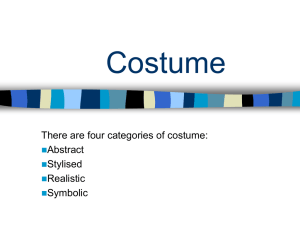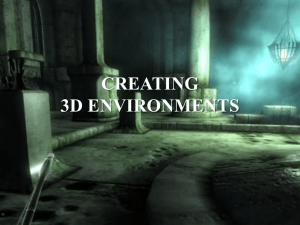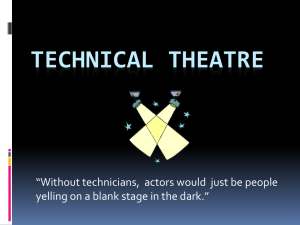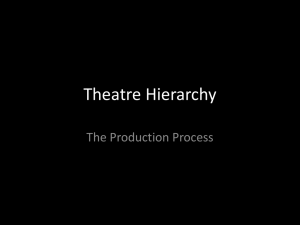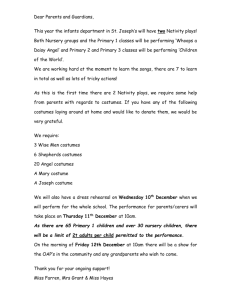Assessment criteria - Novato Unified School District
advertisement
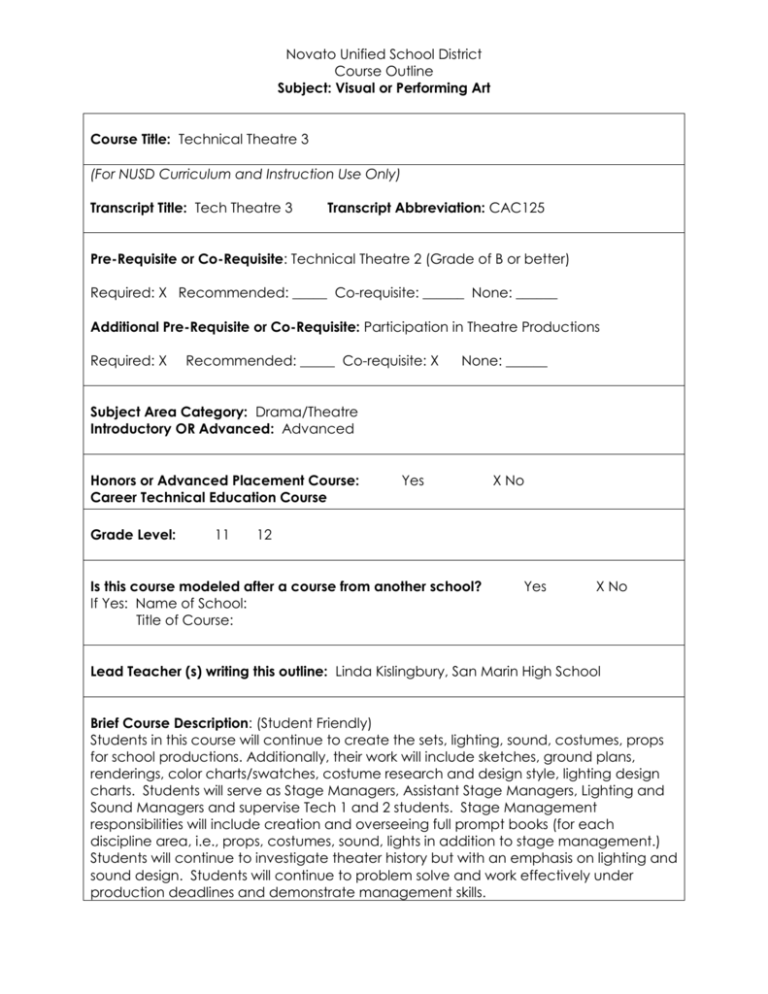
Novato Unified School District Course Outline Subject: Visual or Performing Art Course Title: Technical Theatre 3 (For NUSD Curriculum and Instruction Use Only) Transcript Title: Tech Theatre 3 Transcript Abbreviation: CAC125 Pre-Requisite or Co-Requisite: Technical Theatre 2 (Grade of B or better) Required: X Recommended: _____ Co-requisite: ______ None: ______ Additional Pre-Requisite or Co-Requisite: Participation in Theatre Productions Required: X Recommended: _____ Co-requisite: X None: ______ Subject Area Category: Drama/Theatre Introductory OR Advanced: Advanced Honors or Advanced Placement Course: Career Technical Education Course Grade Level: 11 Yes X No 12 Is this course modeled after a course from another school? If Yes: Name of School: Title of Course: Yes X No Lead Teacher (s) writing this outline: Linda Kislingbury, San Marin High School Brief Course Description: (Student Friendly) Students in this course will continue to create the sets, lighting, sound, costumes, props for school productions. Additionally, their work will include sketches, ground plans, renderings, color charts/swatches, costume research and design style, lighting design charts. Students will serve as Stage Managers, Assistant Stage Managers, Lighting and Sound Managers and supervise Tech 1 and 2 students. Stage Management responsibilities will include creation and overseeing full prompt books (for each discipline area, i.e., props, costumes, sound, lights in addition to stage management.) Students will continue to investigate theater history but with an emphasis on lighting and sound design. Students will continue to problem solve and work effectively under production deadlines and demonstrate management skills. Novato Unified School District Course Outline Subject: Visual or Performing Art Course Purpose (Includes course goals and major student outcomes) Course goals and/or major student outcomes Students will develop their own designs and execute them with the approval of director for performance. Students will explore the connections between design elements and the give and take of production meetings, designers working with other designers and the director and post production audits. Students will continue to expand their knowledge of production techniques and work independently to problem solve in construction, as crew chiefs of other students. They will learn managerial skills as they supervise tech 1 and 2 students. They will demonstrate school-to work post-secondary transition skills and knowledge. Course Objectives-specific student learning objectives Students will further explore their knowledge of theater vocabulary through discussions, readings and through the written reflections on the design elements of theatrical productions both within and outside school Students will produce their own designs for school productions and work with the director to develop a unified design scheme. Students will continue to research historical and cultural context considerations when designing sets, costumes and hairstyles. Students will construct sets, costumes and execute light and plots and supervise Tech 1 and Tech 2 students. Students will work as designers, (crew chief – lighting/sound), stage managers, assistant stage managers Students will develop portfolios of stage designs, prompt books, etc. Course Outline (in addition to general course outline information, the following areas need to be specifically addressed: Artistic Perception; Creative Expression; Historical and Cultural Context; Aesthetic Valuing; and Connections, Relationships and Applications) Artistic Perception Scenic Design Process Read and analyze script Research the historical period, the locale season of the year, the socioeconomic level and personality of the characters of the play Understand the needs of the director and actors Understand the mood and the spirit of the play Understand the ground plan of the theater (i.e., sight lines, stage equipment, etc.) and policies of the theater Develop general sketches of set design Select the design and create a model, if necessary. Students will understand the elements of Design (: line, shape, mass, measure, etc.) & Color (terminology, mixing colors, practical color use). Creative Expression Stage Management Stage Management and Assistant Stage Managers will oversee the entire production team, crew, and set building and will: Be involved in preproduction meetings with the director, research, planning and Novato Unified School District Course Outline Subject: Visual or Performing Art organization Set up production teams and oversee every production team (tech 1 and 2 students) which will include: props, costumes, sets, crew, house management, and sound (depending on production) Be at rehearsals and take care of the prompt book, which will include blocking, cues, prompting (when actors off book) Be responsible for the timing of the show, cue to cue rehearsals, setting up the theater (with the assistant directors for dress rehearsals), posting set and costume changes back stage, calling the show and backstage etiquette Learn and demonstrate managerial skills Research the history and roles of the stage manager, running crews and development of their roles and responsibilities. Sound Design and Technology Sound Designer will work with director to determine theme music for a show, intermission music, and appropriate sound effects for the production and serve as crew chief on complicated shows Costume Design Oversee the costume process and supervise the costume crew chief/designer Work with the director and costume designer to analyze the script, research the historical period of the play, prepare costume chart for each character, prepare costumes sketches, layout, renderings, and ensure that costume changes are posted backstage. Makeup Oversee the makeup and hair crew Ensure that hairstyles reflect the historical period of the play. Ensure that makeup is correct under the lighting Ensure that crew is cleaning utensils and makeup every night. Historical and Cultural Context Stage Properties Oversee the prop crew (tech 1 and 2 students) who will identify stage props, hand props and decorative props and determine how to acquire props. Develop prop log and cue sheet Create prop table back stage and maintain prop drawers and storage units Obtain the necessary furniture based on historical research of the play Theater History Students will continue to study theater history with an emphasis on the history of lighting and sound design. They will report on the progress of theatrical lighting instruments and influential lighting designers Costume Design Oversee the costume process and supervise the costume crew chief/designer Work with the director and costume designer to analyze the script, research the historical period of the play, prepare costume chart for each character, prepare costumes sketches, layout, renderings, and ensure that costume changes are posted backstage. Select students will serve as class manager in the area of costume design Makeup Oversee the makeup and hair crew Novato Unified School District Course Outline Subject: Visual or Performing Art Ensure that hairstyles reflect the historical period of the play. Ensure that makeup is correct under the lighting Ensure that crew is cleaning utensils and makeup every night. Lighting Students will research and prepare an in depth oral report on lighting design from the Greeks to the present by presenting a report/chart to class. Students will explore research lighting designers and experts in the field of stage lighting. Students will present their work in a detailed report and a poster of the designers, with samples of their lighting creations. Students will have the opportunity to work on internships at repertory theatres in the area Select students will serve as class manager in the area of lighting Sound Design Students will prepare a detailed report on methods of creating sound effects and music from the Greeks to the present. Students will present their work in a detailed report and a poster of the designers, with samples of their sound creations. Select students will serve as class manager in the area of sound Aesthetic Valuing Scenic Design Process Read and analyze script Research the historical period, the locale season of the year, the socioeconomic level and personality of the characters of the play Understand the needs of the director and actors Understand the mood and the spirit of the play Understand the ground plan of the theater (i.e., sight lines, stage equipment, etc.) and policies of the theater Develop general sketches of set design Select the design and create a model, if necessary. Students will understand the elements of Design (: line, shape, mass, measure, etc.) & Color (terminology, mixing colors, practical color use). Connections, Relationships and Applications Lighting Design Determine the functions of lighting for each show, i.e., visibility, selective focus, mood Design lights for different kinds of stages: proscenium, thrust, arena, black box Draw the light plot and use Lighting Key to draw the light plot and create related paperwork, i.e., cue sheets. The lighting designer will be a Crew chief, responsible for the rear projector set up and take down Stage Management Stage Management and Assistant Stage Managers will oversee the entire production team, crew, and set building and will: Be involved in preproduction meetings with the director, research, planning and organization Set up production teams and oversee every production team (tech 1 and 2 students) which will include: props, costumes, sets, crew, house management, Novato Unified School District Course Outline Subject: Visual or Performing Art and sound (depending on production) Be at rehearsals and take care of the prompt book, which will include blocking, cues, prompting (when actors off book) Be responsible for the timing of the show, cue to cue rehearsals, setting up the theater (with the assistant directors for dress rehearsals), posting set and costume changes back stage, calling the show and backstage etiquette Learn and demonstrate managerial skills Research the history and roles of the stage manager, running crews and development of their roles and responsibilities. House Management Oversee the house management team to ensure that the room is clean, food is laid out correctly and house is cleaned up at the end of the show. Key Assignments Artistic Perception Scenic Design Process Read and analyze script Research the historical period, the locale season of the year, the socioeconomic level and personality of the characters of the play Understand the needs of the director and actors Understand the mood and the spirit of the play Understand the ground plan of the theater (i.e., sight lines, stage equipment, etc.) and policies of the theater Develop general sketches of set design Select the design and create a model, if necessary. Students will understand the elements of Design (: line, shape, mass, measure, etc.) & Color (terminology, mixing colors, practical color use). Creative Expression Stage Management Stage Management and Assistant Stage Managers will oversee the entire production team, crew, and set building and will: Be involved in preproduction meetings with the director, research, planning and organization Set up production teams and oversee every production team (tech 1 and 2 students) which will include: props, costumes, sets, crew, house management, and sound (depending on production) Be at rehearsals and take care of the prompt book, which will include blocking, cues, prompting (when actors off book) Be responsible for the timing of the show, cue to cue rehearsals, setting up the theater (with the assistant directors for dress rehearsals), posting set and costume changes back stage, calling the show and backstage etiquette Learn and demonstrate managerial skills Research the history and roles of the stage manager, running crews and development of their roles and responsibilities. Makeup Oversee the makeup and hair crew Ensure that hairstyles reflect the historical period of the play. Ensure that makeup is Novato Unified School District Course Outline Subject: Visual or Performing Art correct under the lighting Ensure that crew is cleaning utensils and makeup every night. Historical and Cultural Context Stage Properties Oversee the prop crew (tech 1 and 2 students) who will identify stage props, hand props and decorative props and determine how to acquire props. Develop prop log and cue sheet Create prop table back stage and maintain prop drawers and storage units Obtain the necessary furniture based on historical research of the play Theater History Students will continue to study theater history with an emphasis on the history of lighting and sound design. They will report on the progress of theatrical lighting instruments and influential lighting designers Costume Design Oversee the costume process and supervise the costume crew chief/designer Work with the director and costume designer to analyze the script, research the historical period of the play, prepare costume chart for each character, prepare costumes sketches, layout, renderings, and ensure that costume changes are posted backstage. Makeup Oversee the makeup and hair crew Ensure that hairstyles reflect the historical period of the play. Ensure that makeup is correct under the lighting Ensure that crew is cleaning utensils and makeup every night. Aesthetic Valuing Scenic Design Process Read and analyze script Research the historical period, the locale season of the year, the socioeconomic level and personality of the characters of the play Understand the needs of the director and actors Understand the mood and the spirit of the play Understand the ground plan of the theater (i.e., sight lines, stage equipment, etc.) and policies of the theater Develop general sketches of set design Select the design and create a model, if necessary. Students will understand the elements of Design (: line, shape, mass, measure, etc.) & Color (terminology, mixing colors, practical color use). Creative Expression Sound Design and Technology Sound Designer will work with director to determine theme music for a show, intermission music, and appropriate sound effects for the production and serve as crew chief on complicated shows Costume Design Oversee the costume process and supervise the costume crew chief/designer Work with the director and costume designer to analyze the script, research the historical period of the play, prepare costume chart for each character, prepare costumes sketches, layout, renderings, and ensure that costume changes are Novato Unified School District Course Outline Subject: Visual or Performing Art posted backstage. Connections, Relationships and Applications Lighting Design Determine the functions of lighting for each show, i.e., visibility, selective focus, mood Design lights for different kinds of stages: proscenium, thrust, arena, black box Draw the light plot and use Lighting Key to draw the light plot and create related paperwork, i.e., cue sheets. The lighting designer will be a Crew chief, responsible for the rear projector set up and take down Stage Management Stage Management and Assistant Stage Managers will oversee the entire production team, crew, and set building and will: Be involved in preproduction meetings with the director, research, planning and organization Set up production teams and oversee every production team (tech 1 and 2 students) which will include: props, costumes, sets, crew, house management, and sound (depending on production) Be at rehearsals and take care of the prompt book, which will include blocking, cues, prompting (when actors off book) Be responsible for the timing of the show, cue to cue rehearsals, setting up the theater (with the assistant directors for dress rehearsals), posting set and costume changes back stage, calling the show and backstage etiquette Learn and demonstrate managerial skills Research the history and roles of the stage manager, running crews and development of their roles and responsibilities. House Management Oversee the house management team to ensure that the room is clean, food is laid out correctly and house is cleaned up at the end of the show. Textbooks Title: Technical Theatre for Nontechnical People Edition: Second Publication Date: 2004 Publisher: Allworth Press Author(s): Drew Campbell Supplemental Textbook Title: Theatrical Design and Productions Edition: Fourth Publication Date: 1997 Publisher: Mayfield Author(s): Michael Gillette Title: The State Management Handbook Edition: 3rd Publication Date: 1987 Publisher: Better Way Books Novato Unified School District Course Outline Subject: Visual or Performing Art Author(s): Daniel Ionazzi Title: Backstage Handbook Edition: Third Publication Date: 1994 Publisher: Broadway Press Author(s): Paul Carter Instructional Methods and/or Strategies Lecture Modeling Production (cooperative learning) Guest Speakers Attendance at live theater performance Video (comparison of theatrical productions and design styles) Project presentations and written assessments by students Oral and written tests Assessment Methods and/or Tools Students need to demonstrate through essays and critiques that they have a working knowledge of specialized theatrical vocabulary. Students must participate in all class activities and all school productions. Students behavior and professional attitude back stage (as a crew chief or stage management), as audience members, and in class will be assessed. Students are rated on industry-standard skills and earn certificates. Assessment criteria Students will be required to keep a portfolio/notebook of their written and design work; portfolios will be assessed per assignment. These portfolios will include class notes, personal reflections/observation and research. A rubric is present to students for the major assignments. Students are rated on appropriate level industry-standard rubrics throughout the year. Students must work on and reflect (written and discussion) on all school productions. Ability to lead and work with others will be assessed during production work. Written work is assessed by content, accuracy (comprehension, historical accuracy, etc. and creativity. Design work is assessed by content, accuracy (period, appropriateness for production), creativity and presentation. Grades on tests and written assignments.
